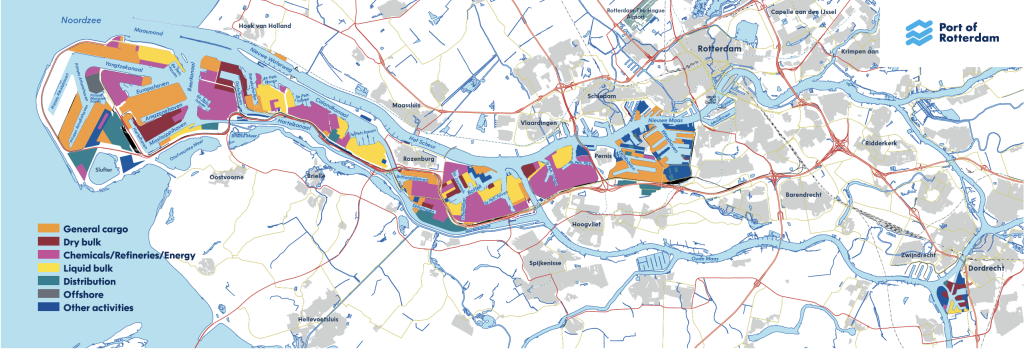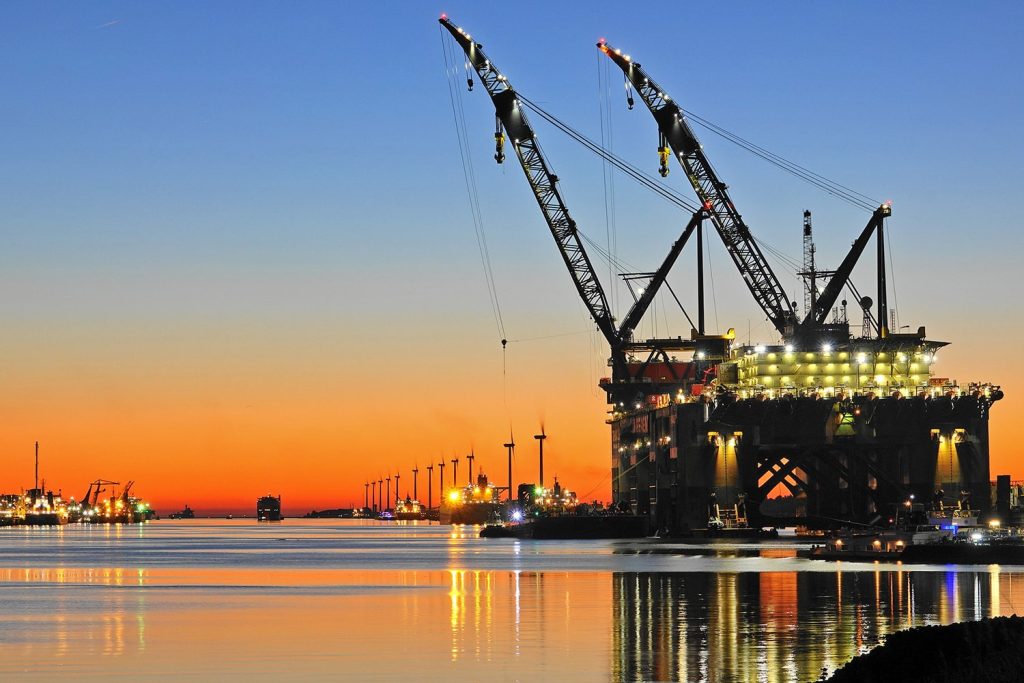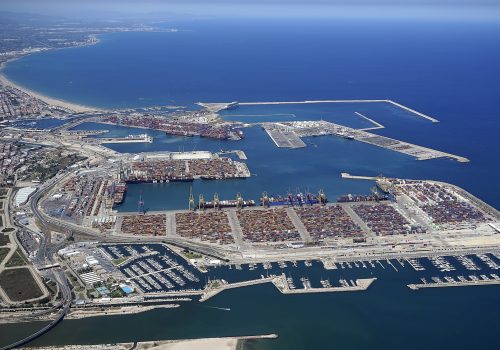Rotterdam, Netherlands: An integrated approach to decarbonization
Rotterdam’s modest size of about six hundred and fifty thousand residents belies its outsized role as a critical hydrocarbon gateway for the European continent. Not only does the port serve as an entry point for fuels that power much of northwestern Europe, but it also serves as a vast industrial complex featuring multiple power plants that convert incoming fuel to electricity for transmission, and refineries that convert crude oil into fuel and a series of petroleum products that are transported elsewhere in the region.
Because Rotterdam’s port operations affect millions of people, the city’s decarbonization efforts are well positioned to have an impact not only within the city, but also far beyond its borders. As such, actions to lower the city’s carbon footprint are the subject of intense interest across Europe, and even the rest of the world.
Rotterdam’s decarbonization strategy is multipronged, technologically oriented, and focused on its port, which contributes to the bulk of the city’s emissions. Rotterdam’s multifaceted strategy includes plans to deploy carbon capture and storage to mitigate the port’s emissions, while also transitioning to greater utilization of clean hydrogen necessary to decarbonize key industrial sectors.
Given Rotterdam’s centrality to Europe and the sheer scale of its port, decarbonizing the city will require a strategic effort involving multiple levels of government, from the Port of Rotterdam all the way to the European Union.

Rotterdam’s carbon footprint
Given the port’s significance for northwestern Europe’s hydrocarbon imports, calculating Rotterdam’s total carbon footprint is not straightforward. The port of Rotterdam, Europe’s largest, is an entryway for imports of coal, crude oil, and liquefied natural gas (LNG) from around the world. It extends inland for forty-two kilometers and features hundreds of facilities, including port operations, and industrial applications such as refining. Some twenty-nine thousand seagoing vessels and nearly one hundred thousand inland (river) vessels enter and exit the port annually.1“Facts and Figures,” Port of Rotterdam, last visited December 12, 2022, https://www.portofrotterdam.com/en/experience-online/facts-and-figures. In 2021, four hundred and sixty-nine million metric tons of goods—dry bulk, containers, and liquids—moved through the port, roughly half of which were hydrocarbons (coal, oil, and liquified natural gas).
Due to the difficulty around measuring the indirect emissions of Rotterdam’s port, this issue brief will examine the city’s Scope 1 emissions—that is, emissions directly attributable to the city. Direct emissions include those from the multiple power plants and oil refineries in the port.
In 2020, the port emitted 22.4 million tons of carbon dioxide (CO2), accounting for nearly 16 percent of all CO2 emissions in the Netherlands.2“Carbon Emissions in Port of Rotterdam Crop Swifter than National Average,” Port of Rotterdam, April 8, 2021, https://www.portofrotterdam.com/en/news-and-press-releases/carbon-emissions-port-rotterdam-drop-swifter-national-average?utm_campaign=&utm_content=C%26EA_NEWS_port-in-action_NB_april_2021_EN&utm_medium=email&utm_source=Eloqua; “Greenhouse Gas Emissions 2.1 Percent Higher in 2021,” Statistics Netherlands, March 16, 2022, https://www.cbs.nl/en-gb/news/2022/11/greenhouse-gas-emissions-2-1-percent-higher-in-2021. The city of Rotterdam reports that the entire municipality, including the port and associated industries, produces approximately 20 percent of the Netherlands’ greenhouse gas emissions, indicating that the port releases a disproportionate share of the city’s carbon emissions.3Ahmed Aboutaleb, “Rotterdam Partners with More than 100 Companies and Social Organizations to Halve CO2 Emissions by 2030,”C40 Cities, January 9, 2020, https://www.c40.org/news/rotterdam-partners-with-more-than-100-companies-and-social-organizations-to-halve-co2-emissions-by-2030/.
Rotterdam’s emissions trajectory, therefore, is largely tied to the port. As shown in Figure 1, the city has made impressive strides in reducing port emissions, from 30.6 million metric tons of CO2 in 2016 to 22.4 million metric tons in 2020, a 27-percent reduction in just four years, far outweighing the 5 percent decline in throughput at the Port from 2016 to 2020.4“Highlights of 2020 Annual Report,” Port of Rotterdam Authority, February 2021, https://jaarverslag2020.portofrotterdam.com/FbContent.ashx/pub_1000/downloads/v210309100611/Annual-report-highlights-Port-of-Rotterdam-2020.pdf; “Highlights of the 2016 Annual Report,” Port of Rotterdam Authority, February 2017, https://www.portofrotterdam.com/sites/default/files/2021-06/highlights-annual-report-2016-port-of-rotterdam-authority.pdf. Although disruptions from COVID-19 undoubtedly contributed to the sharp decline in 2020 emissions, CO2 emissions reductions can largely be attributed to a decline in the use of coal-fired power. 2016 to 2020 witnessed a 75 percent drop in coal-related emissions, a decrease of more than 10.4 million metric tons.5“Carbon Emissions in Port of Rotterdam Crop Swifter than National Average.” Still, workshop participants indicated that Russia’s invasion of Ukraine threatens to reverse some of this progress, as natural gas shortages are leading to a rebound in coal generation.
While natural gas CO2 emissions levels at the port nearly tripled from 2016 to 2020, the decrease in coal-related emissions outpaced the expanded use of natural gas. Given that Dutch generation from natural gas rose by 39 percent from 2016 to 2020, it is likely that some of Rotterdam’s previous coal-fired emissions were replaced by natural gas generation—and related emissions—produced outside of the city’s boundaries.6“Electricity Balance Sheets; Supply and Consumption,” Statistics Netherlands, last updated November 30, 2022, https://opendata.cbs.nl/#/CBS/en/dataset/84575ENG/table?searchKeywords=electricity. Still, on balance, natural gas has lowered Rotterdam’s carbon emissions by displacing coal. This was to be expected. Although natural gas’s methane emissions are a concern, it generates fewer CO2 emissions than coal: one US study found that natural gas yields nine hundred and seventy-six pounds of CO2 for every megawatt-hour of produced electricity, compared with coal at 2,257 pounds.7Glenn McGrath, “Electric Power Sector CO2 Emissions Drop as Generation Mix Shifts from Coal to Natural Gas,” US Energy Information Agency, June 9, 2021, https://www.eia.gov/todayinenergy/detail.php?id=48296.
Coal emissions also fell due to higher generation of electricity from biomass. Rotterdam’s Maasvlakte MPP 3 power station, which opened in 2016, runs on coal, biomass, and residual flows from surrounding industry.8“Maasvlakte Energy Hub,” Uniper Energy, last visited December 12, 2022, https://www.uniper.energy/netherlands/power-plants-netherlands/maasvlakte-energy-hub. It replaced the now-closed MPP 1 & 2 coal-only generators. According to Uniper, the plant’s operator, MPP 3 saves more than one million tons of CO2 each year.9“Electricity Balance Sheets.”
It is important to note, however, that Rotterdam’s story is not exclusively reliant on efforts to switch from coal to gas or biomass. Accelerated deployment of renewable energy has made a major dent in Dutch emissions and, by extension, Rotterdam’s emission profile.10Ibid. As shown in Figure 2, solar and wind power constituted nearly 20 percent of the Netherlands’ electricity generation in 2020, up from 9 percent in 2016. As a percentage of overall consumption, renewable energy’s growing share of electricity generation is displacing hydrocarbons, particularly coal.
Despite access to lackluster sunlight resources, the Netherlands nevertheless has expanded solar generation by nearly 450 percent from 2016 to 2020, as solar’s share of all electricity generation rose from 1 percent to 7 percent.
While there may be declining returns to greater solar generation in the Netherlands, the nation enjoys excellent onshore and offshore wind resources. Development of offshore wind power generation is slated to play a major role in Rotterdam’s decarbonization future, as the Netherland seeks to deploy 70 GW of new offshore wind capacity by 2050. Still, there are significant challenges that need to be overcome to scale wind energy in the Netherlands. Despite the nation’s wind endowments, Dutch onshore wind capacity remains remarkably underdeveloped due in part to parochial concerns about “horizon pollution.” The decarbonization future of the Netherlands—and Rotterdam—will hinge to a large degree on deployment of wind generation.
Rotterdam continues to build on its decarbonizing success by ensuring more accurate monitoring of its port operation emissions. In early February 2022, the Port of Rotterdam Authority teamed up with technology company Big Mile to identify transport-related emissions at the port, with plans to start with ships, and later adding road and rail transport.11“Port of Rotterdam Authority and BigMile Make Transport Emissions Transparent with Digital Platform,” Port of Rotterdam, February 2, 2022, https://www.portofrotterdam.com/en/news-and-press-releases/port-of-rotterdam-authority-and-bigmile-make-transport-emissions. Rotterdam’s improving emissions measurement systems will likely continue to yield real decarbonization progress.
Rotterdam’s decarbonization strategy
Starting around 2016, stakeholders in Rotterdam began developing the procedural bases of a decarbonization strategy. Under the city’s direction, this stakeholder-driven process ultimately resulted in the 2019 Rotterdam Climate Agreement, a document that now constitutes the city’s master decarbonization plan.12“Rotterdam Climate Agreement,” Energieswitch, Rotterdam Climate Alliance, 2022, https://cdn.locomotive.works/sites/5ab410c8a2f42204838f797e/content_entry5ab410faa2f42204838f7990/5be174d6337f770010c1b69f/files/1.2.2_Rotterdam_Climate_Agreement_ENG.pdf. This gradual, multiyear, and consensus-oriented process drew from key industry, government, and civil society stakeholders in Rotterdam and beyond. More than one hundred organizations and one thousand people were involved in the process, which was organized by theme (port and industry, built environment, mobility, clean energy, and consumption).13“Factsheet Rotterdam Climate Agreement,” City of Rotterdam, 2019, https://en.rotterdampartners.nl/app/uploads/2019/11/Factsheet-Climate-Agreement.pdf.
The climate agreement is, therefore, as important for its decarbonization ambitions as it is for the participation and buy-in of major actors across the city, province, and nation.
The original climate agreement sets forth forty-nine climate “deals” that collectively aim to reduce citywide emissions (including at the port) by 49 percent by 2030, as compared to 2017 levels. It focuses on three types of interventions to achieve this goal: increasing energy efficiency through greater utilization of residual heat from industry and other applications; changing the energy system to include additional clean energy electricity generation; and transitioning from fossil fuels to zero-emission energy sources. The national and city governments will fund the projects. In addition, the Port of Rotterdam through its own energy transition plan is prioritizing the three tactics above plus a fourth pillar: making transportation more sustainable. Finally, the city of Rotterdam also launched the Rotterdam Sustainability Compass, which lists all of the city’s sustainability ambitions and outlines energy transition economic opportunities.
Given the overwhelming importance of the port and its large role in emissions, much of Rotterdam’s decarbonization strategy rests on reducing maritime and refinery emissions via production or importation of clean hydrogen or clean ammonia. To meet European climate targets, the city will need to build out significant hydrogen production and import capacity. An emphasis on infrastructure is important given that the Port of Rotterdam assumes that it will have to import eighteen million tons of hydrogen by 2050.14“A New Energy System,” Port of Rotterdam, last visited December 12, 2022, https://www.portofrotterdam.com/en/port-future/energy-transition/a-new-energy-system. In this vision, Rotterdam’s contribution as a critical entrepot for hydrocarbons will shift to an equally strategic gateway for the importation of clean ammonia.
In addition to importing cleaner fuels, Rotterdam is seeking to decarbonize local industrial emissions via greater carbon sequestration and storage. The Porthos project, for example, is designed to transport CO₂ from hard-to-abate industries at the port and store the emissions in empty gas fields underneath the North Sea.15“CO2 Reduction through Storage under the North Sea,” Porthos, last visited December 12, 2022, https://www.porthosco2.nl/en/. Porthos is enormously important to Rotterdam’s objectives, representing about half of the Dutch government’s fiscal support in 2021 for sustainability projects.16“Nearly Half of Dutch 2020 Green Subsidies Go to Rotterdam Carbon Capture Project,” Reuters, June 8, 2021, https://www.reuters.com/world/europe/nearly-half-dutch-2020-green-subsidies-go-rotterdam-carbon-capture-project-2021-06-08/.

Remaining challenges
Rotterdam has already notched several decarbonization wins by employing coal-to-gas, coal-to-biomass, and coal-to-renewables strategies. The next steps will be more difficult and involve more complicated trade-offs. Implementing carbon-capture projects such as Porthos, for example, is expensive and controversial. Likewise, the Netherlands has yet to demonstrate its ability to quickly and dramatically scale offshore wind capacity, which will be crucial for local hydrogen production. Due to the maturity of European offshore wind (OSW) markets, there is little concern over finding funding for OSW projects. Instead, experts consulted for this paper expressed more concern about the lag between project initiation and regulatory approval. The benefits are worth the costs, and the rewards outweigh the risks, however, as progress in green hydrogen and clean ammonia will be vital for reducing emissions in some hard-to-abate sectors and operations at the port, such as refining. To continue decarbonization efforts, Rotterdam should build on its “Climate Deals,” which now stand at over 58 deals. One area for expansion is in sustainable aviation fuel, or SAF. Rotterdam refineries have begun increasing their capacity for SAF and other renewable products. Because SAF is the only viable near-term aviation decarbonization drop-in fuel, the city should incorporate SAF into an updated, expanded Climate Deal framework.17“Deals in Progress,” Rotterdams Klimaatakkoord, accessed March 6, 2023, https://www.rotterdamsklimaatakkoord.nl/klimaatdeals/deals-uitvoering?deal=mobiliteit#heading-mobiliteit; “Neste invests in its world scale renewable products refinery in Rotterdam,” Neste Corporation, press release, June 27, 2022, https://www.neste.us/releases-and-news/renewable-solutions/nesteinvests-its-world-scale-renewable-products-refinery-rotterdam.
Despite local progress, Rotterdam’s cannot control all facets of its decarbonization future. The city’s centrality and reach will be determined in part by regional and global geopolitical, economic, and technological macrotrends. The war in Ukraine provides a powerful and timely illustration, challenging Rotterdam’s climate goals, as local stakeholders stressed to the authors. Russia’s invasion of Ukraine—and Moscow’s quasi-embargo on natural gas exports to Europe—has pressured the continent to increase the use of coal to generate electricity. The Netherlands’ commitment to phase out natural gas production from its Groningen field in North Holland, for example, is leading the government to raise generation at coal-fired power plants.18Cagan Koc and Diederik Baazil, “The Massive Gas Field That Europe Can’t Use,” Bloomberg, October 6, 2022, https://www.bloomberg.com/news/articles/2022-10-06/dutch-close-europe-s-biggest-gas-field-despite-energy-crisis?sref=lDgLmqjg; Bart H. Meijer and Anthony Deutsch, “Netherlands Activates Energy Crisis Plan, Removes Cap on Coal Plants,” Reuters, June 20, 2022, https://www.reuters.com/business/energy/netherlands-activates-energy-crisis-plan-removes-cap-coal-plants-2022-06-20.
AUTHORS
ACKNOWLEDGMENTS
The Atlantic Council would like to thank BP for its support of this project.
This issue brief was written and published in accordance with the Atlantic Council Policy on intellectual independence. The authors are solely responsible for its analysis and recommendations. The Atlantic Council and its donors do not determine, nor do they necessarily endorse or advocate for, any of this issue brief’s conclusions.
The authors would like to thank Maia Sparkman and Elina Carpen for their assistance with this project. In addition, they would like to recognize workshop participants whose contributions helped inform this paper. Participants included the following:
- Andr. Bosman, Director Corporate Communication & Government Relations, Uniper Benelux Corn. Boot, Head of Communications & External Affairs, Netherlands, Belgium, & France, BP
- Frederiek Doedijns, Area Director, Port & Industry, Stedin
- Gillis Oudeman, Head of Public Affairs, City of Rotterdam
- Katelien van den Berge, Coordinator, Energy Transition, City of Rotterdam
RELATED CONTENT

The Global Energy Center develops and promotes pragmatic and nonpartisan policy solutions designed to advance global energy security, enhance economic opportunity, and accelerate pathways to net-zero emissions.


